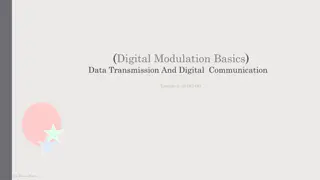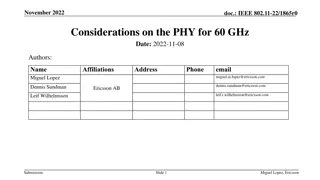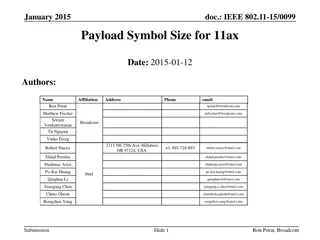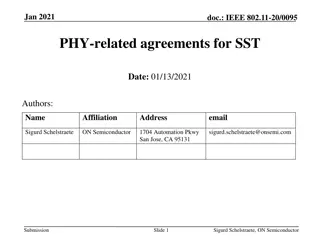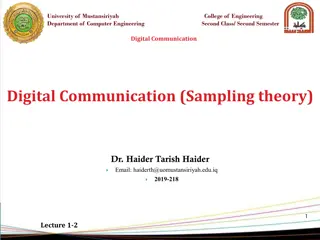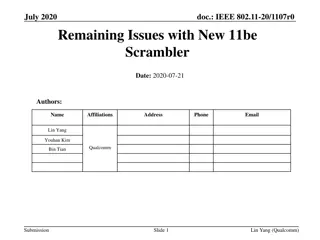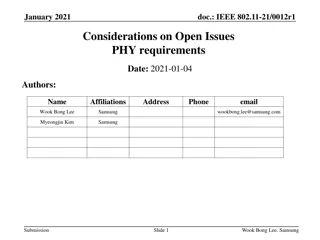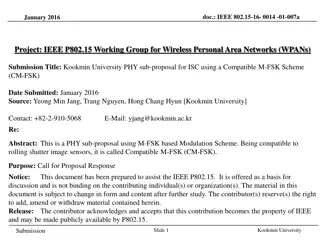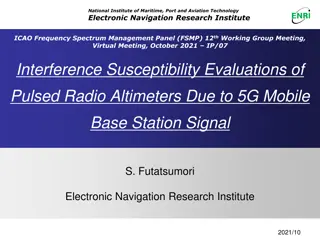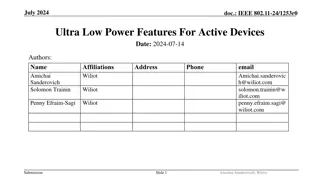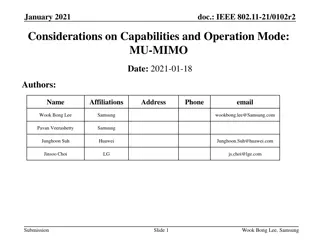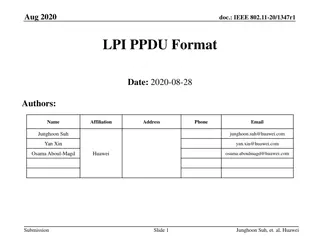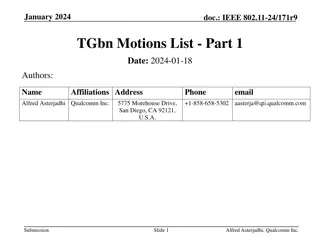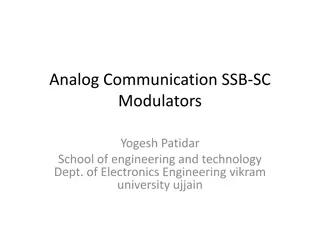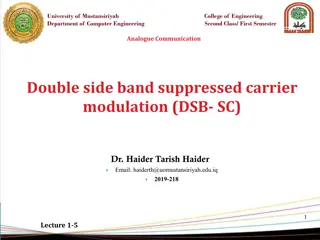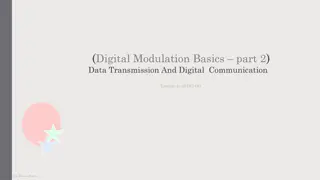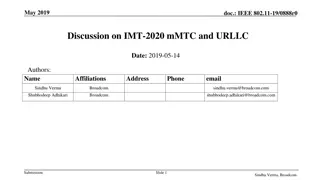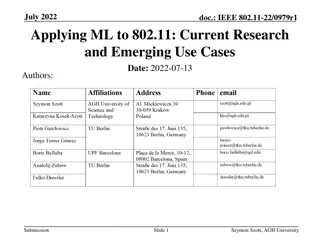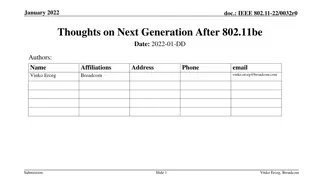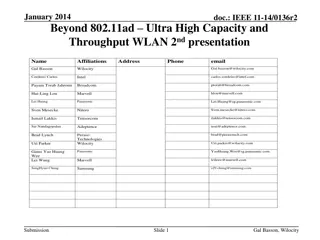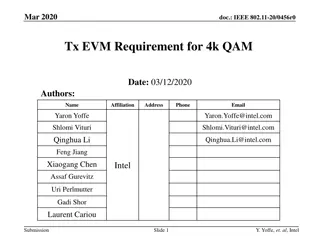Evaluation Results on Payload of Pulsed Modulation PHY for IEEE 802.15-18-0171-02-0013
This document presents the evaluation results on the payload of Pulsed Modulation PHY for TG13, focusing on detection probability, BER vs SNR for header and payload, and coding considerations. It discusses the application of RS code for payload simulations and highlights the adjustments made for successful implementation. The findings aim to contribute to IEEE 802.15.13 discussions, providing valuable insights for wireless personal area networks.
Download Presentation

Please find below an Image/Link to download the presentation.
The content on the website is provided AS IS for your information and personal use only. It may not be sold, licensed, or shared on other websites without obtaining consent from the author. Download presentation by click this link. If you encounter any issues during the download, it is possible that the publisher has removed the file from their server.
E N D
Presentation Transcript
April 2018 Project: IEEE P802.15 Working Group for Wireless Personal Area Networks (WPANs) doc.: IEEE 802.15-18-0171-02-0013 Submission Title: Evaluation Results on Payload of PM PHY Date Submitted: 27 April 2018 Source: Sang-Kyu Lim, Jin-Doo Jeong, Il Soon Jang, Tae-Gyu Kang [ETRI] Address: 218 Gajeong-ro, Yuseong-gu, Daejeon, 34129, Korea Voice:[+82-42-860-1573], FAX: [+82-42-860-5218], E-Mail:[sklim@etri.re.kr] Re: Abstract: This document provides the evaluation results on payload of Pulsed Modulation PHY to TG13. Purpose: Contribution to IEEE 802.15.13 Notice: This document has been prepared to assist the IEEE P802.15. It is offered as a basis for discussion and is not binding on the contributing individual(s) or organization(s). The material in this document is subject to change in form and content after further study. The contributor(s) reserve(s) the right to add, amend or withdraw material contained herein. Release: The contributor acknowledges and accepts that this contribution becomes the property of IEEE and may be made publicly available by P802.15. Submission Slide 1 Sang-Kyu Lim (ETRI)
April 2018 doc.: IEEE 802.15-18-0171-02-0013 Evaluation Results on Payload of PM PHY Sang-Kyu Lim, Jin-Doo Jeong, Il Soon Jang, Tae-Gyu Kang [ETRI] Submission Slide 2 Sang-Kyu Lim (ETRI)
April 2018 doc.: IEEE 802.15-18-0171-02-0013 Evaluation Framework of PM PHY Preamble : Detection probability (for false alarm rate = 0.1%) vs. SNR (cf. doc. 15-18-0106/r0) and required SNR where prob. of misdetection (timing error) < 0.1% Header : BER vs. SNR for the header incl. 8B10B and RS(36,24) coding assuming random data for the header information Payload : BER vs. SNR for the payload incl. 8B10B or HCM and RS(255,248) coding assuming random data for the payload Results are expected for AWGN, D3 in scenario 3 and D7 in scenario 4 (Fig. 25) where LED1-6 are used together from https://mentor.ieee.org/802.15/dcn/15/15-15-0746-01-007a-tg7r1-channel- model-document-for-high-rate-pd-communications.pdf. CIRs: https://mentor.ieee.org/802.15/dcn/15/15-15-0747-00-007a-tg7r1-cirs-channel-model- document-for-high-rate-pd-communications.zip a companion file. In case of questions, please, use TG13 email reflector. Submission Slide 3 Sang-Kyu Lim (ETRI)
April 2018 doc.: IEEE 802.15-18-0171-02-0013 RS code for Payload Simulations Payload : BER vs. SNR for the payload incl. 8B10B or HCM and RS(255,248) coding assuming random data for the payload However, RS(255,248) couldn t be applied to the simulations using MatLab because of a syntax error. So, we replaced RS(255,248) with RS(255,239) for payload simulations, and RS(255,239) has been also applied to G.709 and ETSI-BRAN standards. Submission Slide 4 Sang-Kyu Lim (ETRI)
April 2018 doc.: IEEE 802.15-18-0171-02-0013 D3 in Scenario 3 (Home) Submission Slide 5 Sang-Kyu Lim (ETRI)
April 2018 D7 in Scenario 4 (Manufacturing Cell) doc.: IEEE 802.15-18-0171-02-0013 Submission Slide 6 Sang-Kyu Lim (ETRI)
April 2018 doc.: IEEE 802.15-18-0171-02-0013 Simulation Set-up for Payload (1) ?? ( for 2-PAM Unipolar Signaling ) (1) Theoretical Model ??= ? ?0 (2) AWGN only Model AWGN Payload Data @ OCR = 50 MHz @ OCR = 25 MHz @ OCR = 12.5 MHz @ OCR = 6.25 MHz @ OCR = 3.125 MHz CIR RS(255,239) 8b10b Modulation Receiver Channels + Submission Slide 7 Sang-Kyu Lim (ETRI)
April 2018 doc.: IEEE 802.15-18-0171-02-0013 Simulation Set-up for Payload (2) (3) Uncoded Model AWGN Payload Data @ OCR = 50 MHz @ OCR = 25 MHz @ OCR = 12.5 MHz @ OCR = 6.25 MHz @ OCR = 3.125 MHz CIR RS(255,239) 8b10b Modulation Receiver Channels + (4) RS Model AWGN Payload Data @ OCR = 50 MHz @ OCR = 25 MHz @ OCR = 12.5 MHz @ OCR = 6.25 MHz @ OCR = 3.125 MHz CIR RS(255,239) 8b10b Modulation Receiver Channels + Submission Slide 8 Sang-Kyu Lim (ETRI)
April 2018 doc.: IEEE 802.15-18-0171-02-0013 Simulation Set-up for Payload (3) (5) 8b10b Model AWGN Payload Data @ OCR = 50 MHz @ OCR = 25 MHz @ OCR = 12.5 MHz @ OCR = 6.25 MHz @ OCR = 3.125 MHz CIR RS(255,239) 8b10b Modulation Receiver Channels + (6) (RS+8b10b) Model AWGN Payload Data @ OCR = 50 MHz @ OCR = 25 MHz @ OCR = 12.5 MHz @ OCR = 6.25 MHz @ OCR = 3.125 MHz CIR RS(255,239) 8b10b Modulation Receiver Channels + Submission Slide 9 Sang-Kyu Lim (ETRI)
April 2018 doc.: IEEE 802.15-18-0171-02-0013 Simulation Set-up for Payload (4) (7) (8b10b+RS) Model AWGN Payload Data @ OCR = 50 MHz @ OCR = 25 MHz @ OCR = 12.5 MHz @ OCR = 6.25 MHz @ OCR = 3.125 MHz CIR RS(255,239) 8b10b Modulation Receiver Channels + (8) (8b10b+RS+R-8b10b) Model * RB = Redundancy Bits 8b10b for RB AWGN Payload Data @ OCR = 50 MHz @ OCR = 25 MHz @ OCR = 12.5 MHz @ OCR = 6.25 MHz @ OCR = 3.125 MHz CIR RS(255,239) 8b10b Modulation Receiver Channels + Submission Slide 10 Sang-Kyu Lim (ETRI)
April 2018 Results for D3 in S3 @ OCR = 3.125 MHz doc.: IEEE 802.15-18-0171-02-0013 Number of bits = 7,342,080 BER SNR (dB) Submission Slide 11 Sang-Kyu Lim (ETRI)
April 2018 Results for D3 in S3 @ OCR = 6.25 MHz doc.: IEEE 802.15-18-0171-02-0013 Number of bits = 7,342,080 BER SNR (dB) Submission Slide 12 Sang-Kyu Lim (ETRI)
April 2018 Results for D3 in S3 @ OCR = 12.5 MHz doc.: IEEE 802.15-18-0171-02-0013 Number of bits = 7,342,080 BER SNR (dB) Submission Slide 13 Sang-Kyu Lim (ETRI)
April 2018 Results for D3 in S3 @ OCR = 25 MHz doc.: IEEE 802.15-18-0171-02-0013 Number of bits = 7,342,080 BER SNR (dB) Submission Slide 14 Sang-Kyu Lim (ETRI)
April 2018 Results for D3 in S3 @ OCR = 50 MHz doc.: IEEE 802.15-18-0171-02-0013 Number of bits = 3,671,040 BER SNR (dB) Submission Slide 15 Sang-Kyu Lim (ETRI)
April 2018 Results for D7 in S4 @ OCR = 3.125 MHz doc.: IEEE 802.15-18-0171-02-0013 Number of bits = 7,342,080 BER SNR (dB) Submission Slide 16 Sang-Kyu Lim (ETRI)
April 2018 Results for D7 in S4 @ OCR = 6.25 MHz doc.: IEEE 802.15-18-0171-02-0013 Number of bits = 2,447,360 BER SNR (dB) Submission Slide 17 Sang-Kyu Lim (ETRI)
April 2018 Results for D7 in S4 @ OCR = 12.5 MHz doc.: IEEE 802.15-18-0171-02-0013 Number of bits = 917,760 BER SNR (dB) Submission Slide 18 Sang-Kyu Lim (ETRI)
April 2018 Results for D7 in S4 @ OCR = 25 MHz doc.: IEEE 802.15-18-0171-02-0013 Number of bits = 1,529,600 BER SNR (dB) Submission Slide 19 Sang-Kyu Lim (ETRI)
April 2018 Results for D7 in S4 @ OCR = 50 MHz doc.: IEEE 802.15-18-0171-02-0013 Number of bits = 2,447,360 BER SNR (dB) Submission Slide 20 Sang-Kyu Lim (ETRI)
April 2018 doc.: IEEE 802.15-18-0171-02-0013 Summary BER vs. SNR characteristics for the header were evaluated under 8 simulation set- up (theoretical, AWGN only, uncoded, RS(255,239), 8b10b, RS(255,239)+8b10b, 8b10b+RS(255,239), 8b10b+RS(255,239)+R_8b10b) conditions. The channel effects caused by ISI are shown from when OCR is lower rates, compared to the best sampling. I think it s because we used down-sampling through averaging process in this simulation. The best performance was obtained when we consider only RS code, but we also have to think that 8b10b is used for flicker mitigation. So, from the flicker mitigation point of view, (8b10b+RS+ R_8b10b) combination is better than (RS+8b10b) in BER performance. Submission Slide 21 Sang-Kyu Lim (ETRI)





